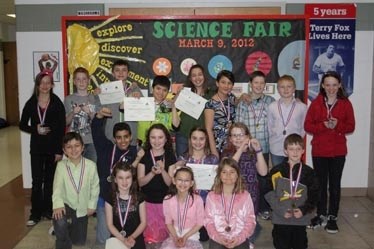There was a whole lot of science going on at Barrhead Elementary School on March 9 as students in Grade 3-6 took part in the school’s annual science fair.
A total of 45 projects were on display, covering a range of topics from the planets in the solar system to how to make a hovercraft, and from the veracity of astrology to how mountains are formed.
In addition to displaying their projects, the students were also being judged by members of the community. Among the judges was Footworks’ Irene Widdup, Pembina Hill school division trustee Dale Schaffrick, Mayor Brian Schulz and numerous parents. The only catch with judging was that you couldn’t judge the same grade your children were in.
For Lou Steeves, a member of the science fair committee, having the students do a project and then have to present it is a wonderful learning experience.
“They become the teachers of their subject,” she said. “They learn about it by researching it and then having to present it.”
One of the more messy projects was that of Lisa Vanloon and Dylan Sekulich. They had chosen to tackle the well-known Internet sensation of Diet Coke and Mentos.
Their goal? To determine which of Diet Coke, Coke, Pepsi, ginger ale and orange soda produced the largest reaction.
Their findings were both somewhat surprising. While Diet Coke was the most reactive and produced a 240.03-cm jet of fizz, the second-most reactive soft drink was the ginger ale at 198.12 cm.
Through their experiment, the girls discovered that it was a combination of acid and carbon dioxide that caused the reaction. In particular, they found the Diet Coke contained a lot more carbon dioxide and therefore produced a greater jet of fizz when mixed with the Mentos.
Unfortunately, the girls were not allowed to demonstrate their experiment in the school’s gym.
Sinead O’Neill had a less messy project, but one that still had a large visual impact.
Her experiment was to see if coloured water could change the colour of a plant. Using food colouring and water, she put a celery stalk and a carnation into each colour and let them sit for a few hours.
When she checked on her experiment a day later, the celery and carnations all showed the effect of absorbing coloured water. The change was dramatic when compared to a control sample sitting in clear water.
Steeves acknowledged that the calibre of the presentations varied depending on the grade level, age and experience of the students. As students are not required to do a science fair project, some were only at the beginning of their science fair careers, while others had several projects under their belts.
When the judging was all over, and the scores were tallied up, four students had claimed the $100 first prize in their grade.
Jacob Stephani’s investigation into the best gas to use in a Ski-Doo earned him first place in the Grade 3 division. He discovered that aviation gas was the best, beating out regular and premium.
Breanna Wegewitz won the Grade 4 division with her look into what effect different liquids have on human teeth.
Teron Callihoo took home first place for Grade 5s with his experiment to determine what materials can absorb oil from water the most effectively. This was also his third consecutive year winning his grade.
For the Grade 6 division, Mazen Elkhouly took top honours for his test to determine whether you can save money by using a dimmer switch.



